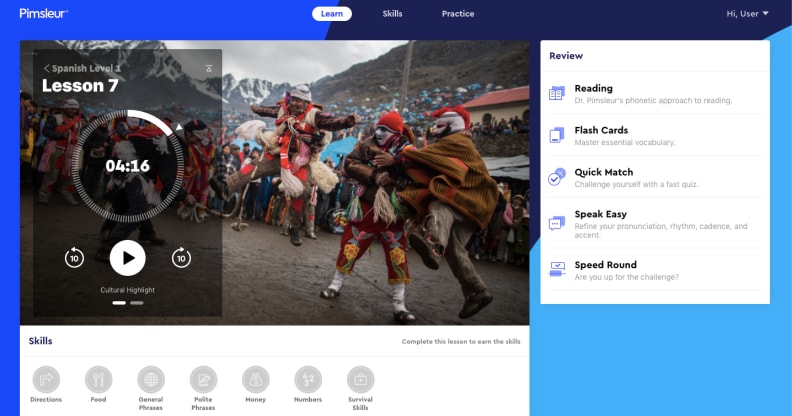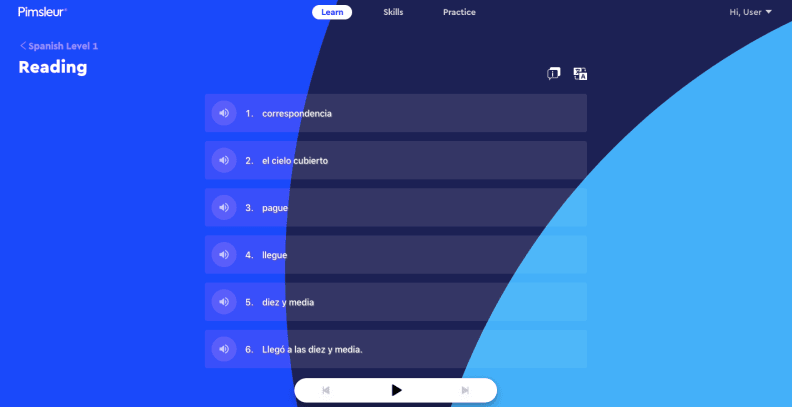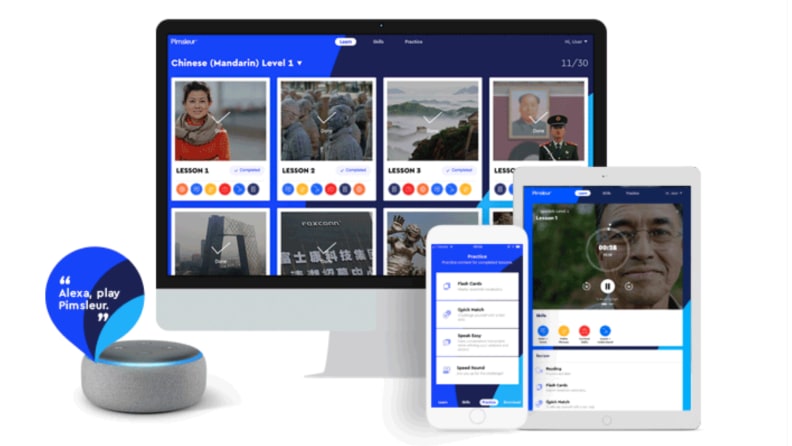This language learning app is perfect for beginners
Pimsleur's approach takes intimidation out of learning
 Credit:
Ruby Smith
Credit:
Ruby Smith
Products are chosen independently by our editors. Purchases made through our links may earn us a commission.
Learning a new language is one of the best things you can do for your work, your community, and your brain. We know this, but that doesn’t make it easy. I’m proof of this—over a ten-day trip to Spain last year, I only worked up the nerve to point at my menu and say “este, por favor” over and over again like a nervous robot. I wanted to use the limited Spanish I had, but in the moment I froze, tripping over my own tongue thanks to a combination of ignorance and insecurity.
I know I'm not alone in my language intimidation. Thankfully, that means there's no shortage of language learning programs available on the market right now, from old standbys like Rosetta Stone to bite-sized freebies like DuoLingo. I tried out Pimsleur, one of the programs in the former category, that promises to get you speaking at an intermediate level in just a month of use.
What is Pimsleur?

Pimsleur's clean, attractive interface helps it feel user-friendly and approachable
Founded by Dr. Paul Pimsleur and owned by Simon & Schuster, Pimsleur Language Programs have been on the market in various forms since 1963. Pimsleur is an audio-based language learning program, accessible online through its website or app. The content is divided into 30-minute lessons, and Pimsleur encourages you to complete one lesson a day. A majority of the content is audio, but each lesson is coupled with optional (but encouraged) short lessons in reading and pronunciation, along with games and flashcards to help you learn new vocabulary.
Pimsleur stresses conversational skills, introducing grammar and vocabulary through context. There are no lists of words to memorize, no conjugation charts, and almost no interaction with your screen. If you have ever tried learning a language with a language tape, this method will probably feel familiar. For users who are more familiar learning languages in a text-based classroom, it might take a minute to adjust.
I tried the first two weeks of Pimsleur’s Spanish program. In Spanish, Pimsleur offers five levels with thirty lessons per level, adding up to seventy-five hours of audio content.
How much does Pimsleur cost?
If you want to buy the entire Spanish language program, it’ll set you back $550. That’s a pretty substantial chunk of change, especially if you’re not sure you’ll love the program. Luckily, Pimsleur offers both a free seven-day trial, and an alternative pricing scheme. Rather pay a set monthly fee? You can opt for a Pimsleur subscription, which costs $14.95 per month.
Let’s break that down. My Spanish program includes 150 lessons total. If I lived an ideal, perfectly balanced life, and actually did exactly one new lesson every single day, I’d finish the program in five months. If I had a subscription with Pimsleur, these five months would cost me about $75.
There’s a pretty big gap between $75 and $550! I’d have to subscribe to Pimsleur for thirty-seven months before the subscription became more expensive than buying the entire program. So if you think you can complete those 150 lessons in under three years—or, better yet, in just 150 days—this is a pretty good deal.
The math isn’t the only thing to consider, though. There are plenty of reasons you might want to pay for the whole program. For one thing, it’s nice to know that the program is yours. With the flat purchase, you could put Pimsleur down for five years, and then come back to it when you’re ready. You also might want a break before moving between levels—college students don’t take five semesters of Spanish in one go, after all. Pimsleur also encourages you to revisit old lessons if you need extra practice, and you might be less likely to do this if you’re watching the clock.
What languages does Pimsleur offer?
Pimsleur currently offers fifty-nine languages, with more than 200 courses covering various dialects. Pimsleur also offers fourteen variations on their English language program, designed for speakers of fourteen different native languages.
You can see a full list of Pimsleur’s courses on its website.
How does Pimsleur work?

Sometimes I sat to focus on my lesson, but the audio-heavy program meant I could also cook or clean while I studied
The first time you open a Pimsleur program, you’re greeted with “Dr. Pimsleur’s Golden Rules”: respond out loud, don’t take notes or look anything up during lessons, and stick to one lesson a day. If you follow these rules, Pimsleur claims, you’ll be able to pick up the language through the conversations and narratives that make up a bulk of the program. Pimsleur stresses understanding a language’s sound system, and blends new and old vocabulary into each lesson so you have ample chance to absorb what you’ve learned.
If you’re familiar with apps like DuoLingo, I should note upfront that Pimsleur is nothing like that. It’s closer to the experience of listening to a learning tape, with very little digital interaction. You could plausibly complete an entire Pimsleur program without looking at your screen (check out our smart speaker recommendations, if you want to do just that).
That being said, Pimsleur is highly interactive. It’s designed for the user to speak along with the conversation, both filling in vocabulary (i.e., ”How do you say restaurant in Spanish?”) and responding to conversational prompts (“Tell Juan that you’ll meet him in the restaurant”). The program is guided by an English-speaking narrator, who points out important context and information you might otherwise miss. Instead of saying, “Now we’re going to learn how to conjugate verbs,” for example, the Pimsleur narrator just says, “Notice that the end of the word has changed,” and encourages you to figure out these differences instinctively. The entire program is designed to get you comfortable with vocabulary and study without needing to memorize or study.
Part of the key to this process is that you are introduced to new words by sound, rather than sight. You won’t read a word the first time (or first dozen times) that you say it aloud. This might sound intimidating to people more accustomed to visual learning styles, but Pimsleur makes it easier for these words to stick in a number of ways—not least of which is pure repetition.
When Pimsleur introduces a tricky new word, it breaks it down one syllable at a time, and if you follow up your audio lesson with the quick reading lesson, you will get a chance to see new vocabulary spelled out. These reading lessons are simple, essentially just including a list of new words to read through so you can recognize them by sight, but I found they went a surprisingly long way toward cementing vocabulary in my mind.
What I liked about Pimsleur

Pimsleur's reading lessons are simple, but they helped new vocabulary stick in my head
I’ll just say it: I loved Pimsleur. It really worked for my style of learning. The audio-heavy method forced me to actually retain vocabulary, rather than just recognizing the way a word looked on a page, and I found that vocabulary was introduced at a pace I could keep up with without becoming discouraged.
I’m a huge fan of another acclaimed language learning program: the Michel Thomas method. In this method, students learn new languages through analysis, context, and conversation. The key to the Thomas method is that students neither study nor memorize—instead, they think through the logic of a new language, and learn to understand its rules instinctively. I knew I was going to like Pimsleur from the first lesson, when I realized how much it had in common with the Thomas method. If this is an approach that works for you, or if you know that you retain information best through a combination of subconscious integration and analysis, Pimsleur will probably work for you.
I studied French for years, but before Pimsleur my Spanish study was limited to parroting “cocodrilo” in third grade. At a certain point, believing that you’re “bad” at a skill can make practicing pretty intimidating. I don’t know if I’d have the guts to take a beginner Spanish course a few weeks ago, but Pimsleur gave me the opportunity to practice the sound of the language in private, to the point that I’m no longer struggling to figure out how I should move my mouth.
Part of my new comfort with the Spanish sound system is just because using a digital program allowed me to practice in private, without fear of sounding stupid or going too slowly. Another part of it is how Pimsleur introduces new vocabulary. When a complex word appears in a lesson, the narrator pauses to break down the word syllable by syllable, starting from the end of the word and working to the beginning. Something about saying the word backwards really clicked with me, and allowed me to hear and repeat individual sounds without tripping over my own tongue. It reminded me of drawing a picture upside down—a common exercise to help artists see shapes and colors, instead of the sum of their parts.
What I didn't like about Pimsleur

When the mobile app was actually working, I liked that I could do my lesson on the go
For the most part, I completed my Pimsleur lessons from my laptop, practicing Spanish as I cleaned or cooked dinner. I liked that Pimsleur also offers an attractive, user-friendly mobile app, and I tried completing a handful of lessons on the go. I quit using the app because I found I got too distracted when I was multitasking, and also because the app crashed about one every third lesson. It wasn’t unusable by any means, but it was a little bit annoying, and based on app reviews, I’m definitely not the only person who had this problem. However, the brand did tell me they were working to fix app issues as they arise, and that a new version of the app that addresses this bug should be released soon.
While I like that Pimsleur introduces vocabulary gradually, it does not offer any flexibility about what content is prioritized, and its organic pace might be a little slow for someone planning for a trip or an event. This worked for me, as someone who is essentially learning a language for personal fulfillment, but Pimsleur won’t be able to adjust to more specific needs.
My final criticism? All respect to Dr. Pimsleur himself, but I gotta say, "Pimsleur" doesn't exactly roll off the tongue.
Is Pimsleur a good way to learn a language?

The Pimsleur method worked for me.
Pimsleur really worked for me, but I want to acknowledge that my experience was a pretty specific one. I might not be a Spanish speaker, but I have studied Romance languages long enough that I’m familiar with their general logic. Spending hours in a classroom fixing misplaced accent marks might not automatically make you a great conversationalist, but it does help you understand the cadence and rules of a language.
I really liked that Pimsleur asked you to pick up on grammar rules piece by piece, but I did feel like my background studying other languages gave me a cheat code, so these portions of the lesson were a lot easier.
Trying to control for this, I also tried the introductory lessons for Arabic and Korean. This pretty much showed me what I suspected: I could move along a lot faster when I had some baseline familiarity with a language. That being said, I still thought the Pimsleur approach was pretty remarkable. Pimsleur begins each lesson by playing a conversation, with the promise that by the end of the lesson, you will be able to understand it.
As someone with no knowledge of Korean whatsoever, I find it challenging to even distinguish individual words. Breaking down a conversation with Pimsleur was magical in the way all learning is—I could identify the moment I started to hear the words for what they were.
For a language that’s completely new to me, I’d allocate a lot more time, and probably replay the same lessons a lot more often. This is part of Pimsleur’s expectation, however, rather than a failing. To me, the biggest reason I might avoid Pimsleur is the relatively steep price, though opting for a subscription is far more cost effective than buying the software. For pedagogy, content, and just the opportunity to learn at my own pace, I’d say that Pimsleur is absolutely worth the investment.
After a few weeks with the Spanish Pimsleur program, I’m certainly not fluent—but I can order myself a beer, and most importantly, I feel like I can confidently keep on learning. The systematic way Pimsleur introduces new sounds, coupled with the even pacing and recurrence of previously learned words, made this a really successful, rewarding, and educational experience.
